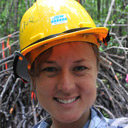Borneo’s carbon sink
The decimation of Borneo’s forests over the past half century is well known. Every tree lost releases carbon into the atmosphere, hastening climate change.
But over the same time period, a new study has found, the forests that remain – the untouched, old-growth forests of the interior – are getting denser.
For millions of years, exuberant tropical vegetation has sprouted, bloomed and died here. The trees absorb and store carbon as they grow, and release it back into the atmosphere when they die and rot away.
Traditionally it was thought that primary forests like these must have reached a kind of carbon equilibrium – that once a forest is mature, new trees would replace dying ones at a steady rate, and the total amount of living material in a given area would remain roughly the same over time.
But that’s not what is happening in Borneo, or indeed in the world’s other tropical forests. An international team of scientists led by Lan Qie, then at the University of Leeds, analyzed long-term measurements of 71-hectare plots across the huge island, and discovered that over the past half century, Borneo’s intact forest increased in biomass by an average of 430 kilograms per hectare per year.
That means it is acting as a carbon sink, says Qie. And Borneo is not alone. Previous studies have shown the undisturbed tropical Amazon and African forests are also absorbing more carbon than they are releasing.
“We now know this is a global trend,” Qie says. “En masse, across the tropics, these intact forests are out of equilibrium.”
That means that primary forests are probably mopping up some of our excess carbon emissions, and helping to mitigate the effects of climate change.
Why could this be? It still needs to be proven experimentally, she says, but the most likely explanation is that there’s a global driver simulating higher levels of growth, possibly linked to the increasing carbon dioxide levels in the atmosphere.
But there’s only so long old forests can do that. “You can imagine that a patch of forest on a fixed land surface simply can’t be getting larger indefinitely,” says Qie.
“We expect that the faster growth we’re seeing now will maintain the carbon sink in the short term, until tree death catches up, and the forest biomass reaches a new, higher equilibrium.”












